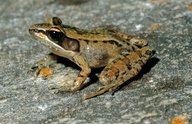|
Description
M 28-35 mm, F 35-45 mm. Tibiotarsal articulation reaches beyond snout tip. Fifth toe longer than third toe. Femoral glands in males large and very prominent. Frenal stripe relatively distinct but fading before reaching the nostril. Ventrally whitish, including the throat. No distinct colour border between dorsum and flanks like in other Chonomantis. Often with a vertebral stripe (Glaw and Vences 2007).
Variation: Specimens from Itremo have a smaller body size, shorter hindlimbs, and their femoral glands are located closer to the cloaca; however, they do not show important genetic differentiation (Glaw and Vences 2007). Distribution and Habitat
Country distribution from AmphibiaWeb's database: Madagascar
Species is located in Ambatomenaloha, Ambohimirandrana, Ambohitantely, Antoetra, Antratrabe, Beanjombona, Farihimazava, Itremo, Manjakatompo, Manjavona valley, Nosiarivo, Soamazaka, Tsiafajavona plateau, Vohisokina (Glaw and Vences 2007).
It has been recorded from 1400-2400 m asl (Nussbaum et. al 2008). Life History, Abundance, Activity, and Special Behaviors
Habits: Found along streams in montane forest, but more commonly in deforested areas or above the tree line. Males call during day and evening from the ground at the edge of streams. Clutches of about 30 eggs are deposited on land (Glaw and Vences 2007).
Calls: A rapid series of five to seven very short notes of slightly melodious appearance (Glaw and Vences 2007).
Trends and Threats
This species is listed as least concern because of its wide distribution, tolerance of a broad range of habitats, presumed large population, and because it is unlikely to be declining fast enough to qualify for listing in a more threatened category (Nussbaum et. al 2008).
It occurs in protected areas such as Réserve Spéciale d’Ambohitantely and the Parc National d'Andringitra. It is probably not affected by deforestation, and is adaptable and is unlikely to be threatened. There might be some threatened cryptic species within this unresolved complex (Nussbaum et. al 2008). Comments
Taken with permission from Glaw and Vences (2007) and Nussbaum et. al (2008).
References
Glaw, F., and Vences, M. (2007). Field Guide to the Amphibians and Reptiles of Madagascar. Third Edition. Vences and Glaw Verlag, Köln.
Nussbaum, R., Cadle, J., and Glaw, F. (2008). Mantidactylus brevipalmatus. In: IUCN 2008. 2008 IUCN Red List of Threatened Species. www.iucnredlist.org. Downloaded on 08 April 2009.
Originally submitted by: Miguel Vences and Frank Glaw (first posted 2003-02-21)
Edited by: Catherine Aguilar (2009-05-01)Species Account Citation: AmphibiaWeb 2009 Mantidactylus brevipalmatus <https://amphibiaweb.org/species/4587> University of California, Berkeley, CA, USA. Accessed Apr 24, 2024.
Feedback or comments about this page.
Citation: AmphibiaWeb. 2024. <https://amphibiaweb.org> University of California, Berkeley, CA, USA. Accessed 24 Apr 2024.
AmphibiaWeb's policy on data use.
|
